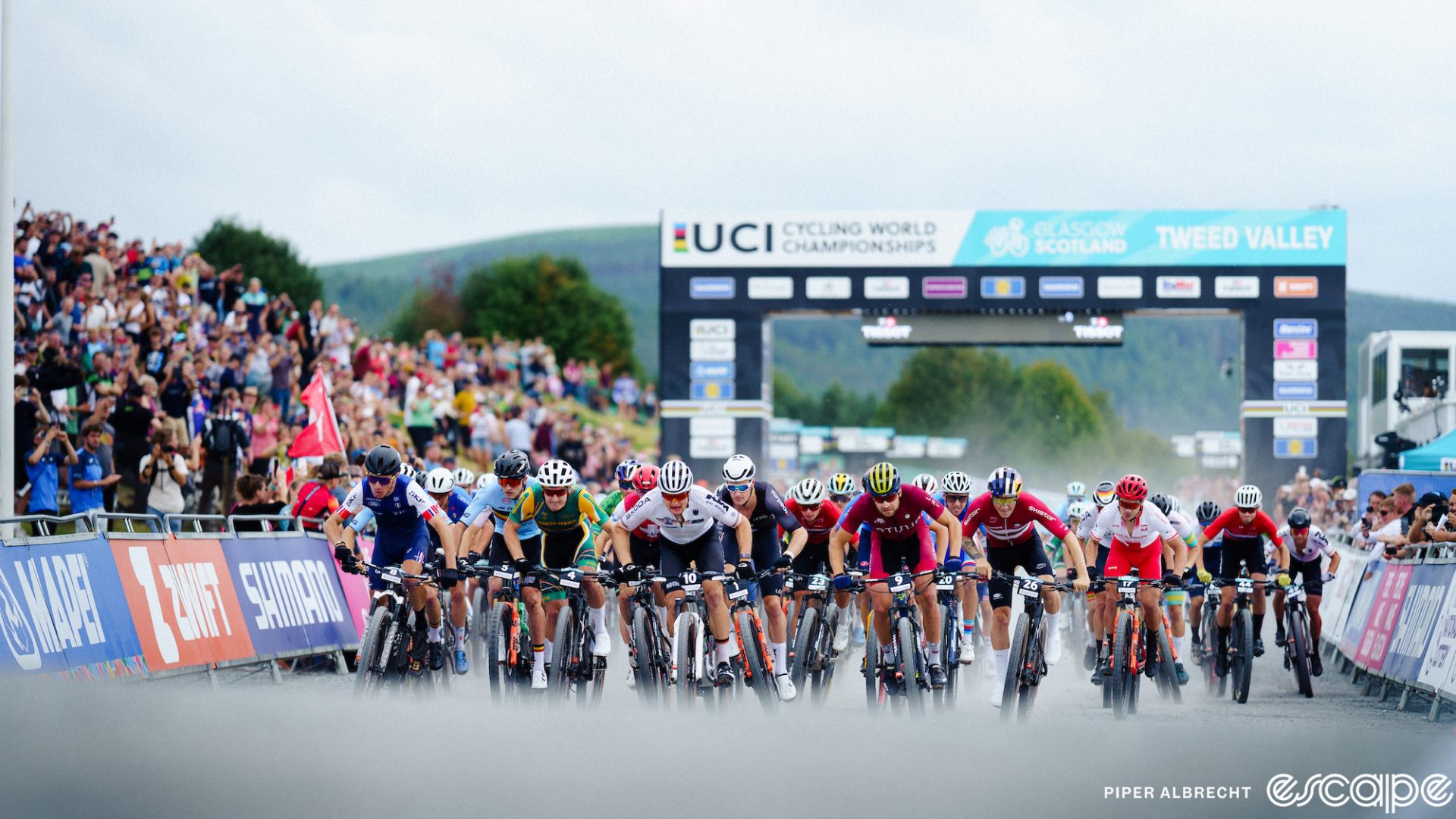Just a day before the cross-country race at the World Mountain Bike Championships, the UCI provoked a major controversy over late changes it made to rules governing positions on the start grid. The new approach is designed to give high-profile riders who specialize in road racing better start positions than they would otherwise have. But the adjustment doesn’t actually fit the rules the UCI cites, and in Peter Sagan’s case, it’s disregarding them entirely. In response, a number of high-profile riders including 10-time World XCO champion Nino Schurter are protesting the change.
Reportedly, the UCI told trade teams about the change the night before the announcement, but didn’t discuss it with rider representatives Maxime Marotte and Rebecca Henderson, who responded with a statement expressing “deep disappointment and frustration” over the shift. “It’s great to have big names from different disciplines in our sport and we can’t wait to race against them,” it began before noting the late rules change. “The concern is the way and timing that UCI has applied and enforced this rule. And the consequences that follow for individual riders and teams with Olympic games [sic] quota positions likely to be impacted.” The statement was signed by Schurter, former World Champions Jolanda Neff and Jordan Sarrou, and more than 20 other elite men and women racers. The UCI did not respond to an e-mailed request for comment from Escape Collective.
What’s going on
In rules for World Cup racing (PDF), start positions 1-32 for long-course cross country (XCO) are determined by the short-track (XCC) results (spots 1-24) from that venue and the most recent UCI ranking (spots 25-32). But at World Championships, according to the technical guide for this year’s event, XCC has no bearing on the long-course start grid, which is determined only by the most recent UCI ranking for the XCO discipline. That means that despite his podium in XCC, Tom Pidcock would start XCO in 61st position, while Mathieu van der Poel and Peter Sagan, who haven’t raced elite XCO since 2021 and 2016, respectively, would be back in the “unclassified riders drawing lots” section.
Obviously, that’s a problem for those three riders and dents at least some of the crossover fan appeal to road audiences. Start grid positions in XCO are vitally important. The field at World Championships is 96 riders, and the start grid will be roughly 10 rows deep. In a race that lasts under an hour and a half, it’s almost impossible to jump into contention from so far back.
That’s pretty harsh for Pidcock, the reigning Olympic champion, winner of the XCO round at Nové Mesto in May, and bronze medalist on Tuesday in the XCC. It’s also harsh for Van der Poel, who has an outside chance to match Pauline Ferrand-Prévot as the only riders to win World Championships in cyclocross, road, and mountain bike in a 12-month period. Tanking the prospects of such talented riders is, understandably, what the UCI is trying to avoid with its rules changes to give them better start spots.
Problem: the UCI does UCI things
The UCI’s World Cup rules do offer an escape clause of sorts: rule 4.10.003 says that any rider ranked in the top 10 in another UCI discipline can start as high as 33rd. That would help out Van der Poel, who’s sixth in the most recent road rankings. Here’s where things start to get weird: those rules say nothing about World Championships (in fact, the UCI’s mountain bike regulations don’t mention Worlds at all, which seems like an oversight; the technical guide for World Championships is silent on how riders from other disciplines mesh into the XCO start grid.
So, in a one-paragraph communique the day before the race, the UCI said “to mirror UCI regulation art. 4.10.003, used in the UCI Mountain Bike World Cup … start places 33rd to 40th in the UCI Mountain Bike World Championships … will include any rider ranked in the top 10 of any individual UCI ranking with the exception of the UCI Road individual world ranking where top 20 will be included.” [Italics mine]

Why that change? Because Pidcock is only 17th in the road rankings. Tweaking the rules is a way to extend the start grid beneficence to him. Of course, the UCI is flagrantly ignoring the fact that its rules change doesn’t actually mirror its start grid regulations for World Cups, because that rule makes no allowance for a deeper pool of qualifying rankings for roadies over, say, cyclocross or BMX or trials riders.
The change also makes it easier for top riders to treat mountain bike racing as a side gig without any real repercussions at the biggest events. That’s bad for XC racing in the long term.
Finally, even if you can reconcile all that, there’s still the question of Peter Sagan with that 35th start spot. That’s because Sagan is not in the top 10, or 20, or 50 of the UCI road rankings. He’s not even in the top 300. That’s right, the former UCI No. 1 road rider in the world is waaaaay back in 311th. But on Saturday, he’ll start in front of newly crowned XCC World Champion Sam Gaze, silver medalist Victor Koretzky, Sam Fox, and Christopher Blevins, to name four riders with top-10 World Cup XCO finishes in either 2022 or 2023.
The UCI offered no rationale for why it handed Sagan such a preferential start spot when he satisfies none of even their new rules. Just as bad, the rules changes came after the U23 races, where in the women’s field Blanka Vas started 49th even though her 10th place in the UCI cyclocross rankings would have given her a spot two rows higher had the UCI acted earlier (she finished fifth even despite that).
All of that is what has riders understandably upset.
The repercussions
On one hand, shifting two-thirds of the field three riders back in the start grid doesn’t seem like a huge deal. It’s not as if there’s a massive influx of extra-discipline riders gumming up the works. But in their joint statement, Marotte and Henderson raise two salient issues. One is the impact on Olympic start spots. Riders aren’t just racing for placings this year; they’re racing to earn start spots for their countries at the Paris Olympics, and there, yes, every start spot they’re pushed back may be the crucial difference between qualifying for the Games and not.
More broadly, the UCI’s late change feels wrong to them because of its abrupt, quixotic nature. All season, riders have raced under a set of rules, only to find out the night before one of the most important races of the year that those no longer apply. If it reeks of favorable treatment, well, it is, and for riders who’ve worked hard all season, it’s hard not to feel that the UCI cares more about the show of the race than the substance of the competition.
There are, certainly, ways to solve this. It seems silly that the reigning Olympic XCO champ has to stoop to relying on his road ranking to qualify in the start grid. It also seems like the World Cup rules that offer up a certain number of XCO start spots to top finishers from the XCC, might be reasonably tweaked to apply at World Championships since both are medal events. Finally, it seems like the UCI might want to actually put rules specifically about worlds in its actual regulations, not just the non-binding technical guide that is later disregarded when convenient for reasons it doesn’t bother to explain, even to the riders.
Piper Albrecht and Ryan Simonovich contributed reporting.
What did you think of this story?

